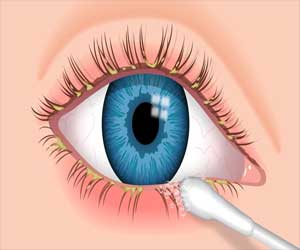- Home
- Editorial
- News
- Practice Guidelines
- Anesthesiology Guidelines
- Cancer Guidelines
- Cardiac Sciences Guidelines
- Critical Care Guidelines
- Dentistry Guidelines
- Dermatology Guidelines
- Diabetes and Endo Guidelines
- Diagnostics Guidelines
- ENT Guidelines
- Featured Practice Guidelines
- Gastroenterology Guidelines
- Geriatrics Guidelines
- Medicine Guidelines
- Nephrology Guidelines
- Neurosciences Guidelines
- Obs and Gynae Guidelines
- Ophthalmology Guidelines
- Orthopaedics Guidelines
- Paediatrics Guidelines
- Psychiatry Guidelines
- Pulmonology Guidelines
- Radiology Guidelines
- Surgery Guidelines
- Urology Guidelines
Permethrin cream safe and effective for treatment of Demodex Blepharitis

Israel: Permethrin might be a safe and effective alternative for the treatment of Demodex blepharitis (eyelid inflammation), according to a recent study.
The study, published in the journal Cornea found that treatment with permethrin 5% cream in Demodex blepharitis patients resulted in improvement of blepharitis signs and symptoms with no reported adverse effects and a decrease in parasite burden.
Blepharitis is an inflammatory condition affecting the area around the base of the eyelashes. It is a very common disorder affecting millions worldwide The underlying causes of chronic blepharitis are not well understood. The most obvious signs of blepharitis are redness and stickiness of the eyelid, with clumping of scaly skin around the base of the eyelashes. Despite advances in diagnostics, very little progress has been made in recent years regarding treatment for this disease.
Idan Hecht, Assaf Harofeh Medical Center, affiliated to the Sackler School of Medicine, Tel Aviv University, Israel, and colleagues evaluated the safety and efficacy of permethrin 5% cream for the treatment of Demodex blepharitis.
For the purpose, the researchers prospectively recruited patients with confirmed Demodex blepharitis and treated with permethrin 5% cream for 6 months. They then regularly assessed blepharitis symptoms, ocular examination findings, ocular surface disease index, and ex vivo eyelash Demodex counts.
Twenty-three patients were recruited, of which 2 were lost to follow up and 21 entered the analysis. Mean patient age was 57.2 ± 16.8 years (range: 24-82 years), and 13 (62%) were women.
Also Read: Blepharitis may be an early sign of metabolic syndrome : BMJ
Key findings of the study include:
- Mean Demodex counts improved after treatment from 1.36 ± 1.233 to 0.48 ± 0.6 parasites per eyelash, and the overall blepharitis symptoms score improved from 42.9 ± 22 to 32.7 ± 21.
- Improvement in disease symptoms (scored on a scale between 0 and 4) was noted including feeling of dry eye (2.85 ± 1.3-1.85 ± 1.7), discharge (1.86 ± 1.7-1.00 ± 1.1), and dandruff-like debris (1.69 ± 1.7-0.9 ± 1.6), as well as clinical findings including a decrease in scaling (on a scale of 1-5; 1.43 ± 0.9-0.86 ± 0.7) and corneal staining with fluorescein (on a scale of 1-4; 1.29 ± 0.4-1.05 ± 0.2).
- No change in the ocular surface disease index score was noted (37.5 ± 24.1-41.63 ± 42.5), and no adverse events were reported.
Also Read: Poor air quality may worsen dry eye disease conditions
"Treatment of Demodex blepharitis with permethrin 5% cream resulted in a decrease in parasite burden and improvement in blepharitis signs and symptoms, with no reported adverse events. Permethrin might be a safe and effective alternative for the treatment of blepharitis associated with Demodex infection," concluded the authors.
To read the complete study log on to doi: 10.1097/ICO.0000000000002013

Disclaimer: This site is primarily intended for healthcare professionals. Any content/information on this website does not replace the advice of medical and/or health professionals and should not be construed as medical/diagnostic advice/endorsement or prescription. Use of this site is subject to our terms of use, privacy policy, advertisement policy. © 2020 Minerva Medical Treatment Pvt Ltd